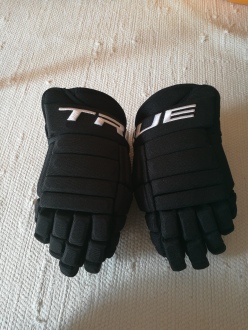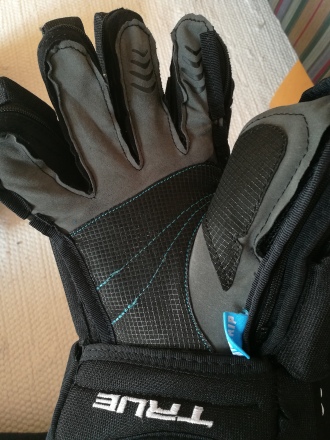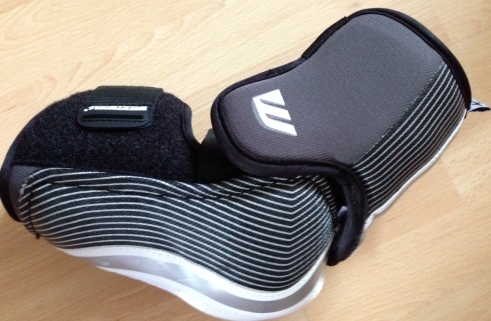
When TRUE Hockey unveiled its Z-Palm glove, it set the hockey world ablaze on social media. People were intrigued and amazed at the design of the glove and were at awe to the potential solution to the age old problem with hockey gloves: The worn out palms.
TRUE Z-Palm gloves feature a unique design element in that you can replace the palm of the glove with relative ease. At a recent hockey convention the fastest time recorded was 25 seconds for a change of palm. So it all sounds good as an idea and in principle, but does it actually work, or does the zip included in the glove make it uncomfortable to wear? Are there any flaws in the glove? Is it really a stroke of genius or a flash in the pan product?
We have been testing the TRUE 6.0SBP Z-Palm gloves for a few months now to find out what the gloves are about and to find out if TRUE has managed to solve the problem that plagues many hockey players across the globe.
Imagine the scene, you have broken in your gloves and they are comfortable as anything on your hands. Then through wear and tear, the palm develops a hole. You might get it re-palmed or covered up, which can sometimes make the overall feel of the glove awkward, or you ignore it and let the hole grow until you fork out for a new pair. It’s a cycle that players go through regularly. Some do it after every season, some mid season and those that are lucky, will hold out until there is no palm left on their glove before they buy new ones.
The benchmark glove we’re testing these against is the Warrior AX1 gloves as this set of gloves, in our opinion is the best in the market in terms of the 4-roll look and feel. The current CCM 4-roll gloves provide a good feel and a good level of protection, but the Warrior AX1 is the better all-round fit at the moment and we are benchmarking the TRUE 6.0 SBP Pro Z-Palm glove against the Warrior AX1.
Out of the box
Out of the box the TRUE A6.0 Z-Palm gloves feel comfortable when you first put them on. The materials within the

glove are breathable and feel comfortable against your skin. The gloves, similar to the Warrior ones, have an almost ready-broken in feel. The TRUE gloves feel like you could walk away from the store and jump straight into a game.
The gloves we tried came with the standard Z-palm palms. The palm felt a little bit thicker and almost heavier than on some of the other gloves. However, on the flipside, the standard Z-palms do provide you with good levels of grip and the materials used in the palms are of high quality. The first impression was, however, that the material might not be as breathable as on the AX1 gloves.
Otherwise, the design of the gloves is minimalistic, but when you look at it and feel the materials, you are confident that you are holding a premium product.
Comfort and Fit:
As mentioned the, materials used in the Z-Palm gloves give you a comfortable feel. The outer shell of the glove comprises of 24mm pro-grade EPP foam and 1mm PE Inserts, which gives you additional protection as most gloves on the market use 20mm size padding in their gloves.
The inner liner of the glove feels comfortable to the hand and is right up there with all the ‘big-boys’. The gloves provide high levels of comfort without sacrificing protection or adding weight. In terms of fit, we have been testing the 13” glove and it fits perfectly well. The only real niggle we’ve come across with them in comparison to your ‘standard’ gloves is that the inner padding and liner can move around when changing the palms, which will lead to some fiddling. It’s not a major flaw by any stretch of the imagination.
What is quite different in comparison to other gloves is the range of movement you get from the thumb. We would argue that the thumb area is more flexible than in others, and certainly we felt that we got a better grip on the stick than compared to other makes of gloves.
Protection:

Gloves are used to protect. That is their main job and in game and training situations, the TRUE gloves perform as you would expect. As mentioned above, the thumb area of the glove is quite flexible. To combat hyperextension injuries that are often result of a fall, TRUE has integrated a protection mechanism, the Trueflex thumb. It is fairly standard in all makes of gloves, but on the TRUE gloves the hyperextension protection is longer and sturdier. For example in the Warrior AX1 and Sher-Wood gloves, you can hyper extend the thumb before you notice that there is anything stopping the motion. With the Trueflex you feel the protection is there and you will be hard pressed to hyperextend the thumb. However, it is important to note that in any piece of equipment features such as these don’t guarantee that they are sure to eliminate injuries, but should significantly reduce the risk.
In fact, the beauty of the Trueflex thumb is in the flexibility of the thumb. You are able to get a far better grip on the stick straight away when you start using the gloves thanks to being able to close your hand into a near-perfect fist in the glove. On other gloves, the thumb is often quite rigid and even on the Warrior gloves which allow for some thumb movement, it doesn’t come close to the TRUE gloves in terms of the grip you are able to get on the stick. This is by far superior when compared to the latest offerings from CCM, Warrior and Bauer.
In terms of the other protective elements, the gloves provide protection on par with top manufacturers in the segment. Thanks to the additional 4mm of padding in the TRUE gloves, you are better off. The protection around the wrist is good, as well as the padding around the fingers. TRUE has achieved a great level of protection whilst not sacrificing comfort of the glove.
Owning:
What we think make the TRUE Z-Palm gloves worth owning is the fact that you can customise your gloves with different palms. You can get the 4-roll look and feel whilst being able to enjoy palm materials usually reserved for anatomically designed gloves.
If you want long life out of your protective equipment, you do need to look after it. One thing that we did notice on few of the palms, mainly in the Pro and grip versions of the palm it can take a while for them to dry out. If you have back to back games, you might come to find that the palm area is still a little damp from the night before.
Having discussed this with TRUE, it is recommended that you partially unzip the palm to allow more air flow through the glove. We have since tried this trick and have noticed that it does indeed speed up the drying process of the glove.
Fitting the palm

The burning question then: how easy is it to replace the palm? Well, we haven’t gotten anywhere near the record time that was set at the exhibition, but it is safe to say that you can do a pair of gloves in between periods if needs be and you’ll have time to listen to instructions from the coaches as well.
Removing a palm is easy and effortless. Here TRUE has done a good job with the design of the glove as the entire palm side of the glove opens up, which helps immensely with the changing process and the zips do not interfere with comfort of the glove.
However, attaching a new palm is something that takes a bit of getting used to. The first few times of putting on a new palm were a little bit of troublesome, but as with everything practice makes perfect. The challenge we’ve faced is in the fitting of a new palm. Once you get to the middle finger, you need to ensure that you keep the zip as straight as possible as there is a tendency of it getting stuck.
What might be an overlooked design element here is that the zip is positioned quite cleverly so that it should not be easily damaged during the game. The only way we see that the Z-palm design could be compromised is by someone stepping/skating on/over your glove from the palm side and by that stage, you’ll have other things on your mind as opposed to a zip.
Overall, the changing process is easy enough, even if putting on a new palm is the more difficult one of the changing process.
Conclusion:
In the past we have called TRUE Hockey as a new-comer to the hockey market, but in the space of few short years, the company has established itself with innovative products in both sticks and now protective equipment in gloves.

The Z-Palm gloves is something that other manufacturers and players will be looking at with envy. The design looks great, they gloves feel great, but the real beauty of the TRUE A6.0 SBP Pro gloves is the Z-Palm innovation. By buying a pair of gloves, you are essentially buying five pairs. You have greater level of customisation opportunities to you and you can try new styles of palms without it costing you a new pair of gloves. The Z-Palm gives you longevity for the gloves as you don’t need to replace the gloves, but rather just the palm. If you are looking for gloves that provide you with good levels of protection, mobility the TRUE gloves should be on your shopping list. What will tip it in TRUE’s favour over any other manufacturer is the Z-Palms. Like said, by buying a set of TRUE gloves, you are essentially buying five pairs of gloves at once, all thanks to the customisation options the Z-Palm affords you.
In comparison to the Warrior AX1 gloves, the TRUE A6.0 SBP Pro Z-Palm gloves stack up equally well. The TRUE glove could end up costing you a bit less (depending on retailer) and you get a bit more for your money thanks to the Z-Palms. In terms of fit and comfort, the gloves are pretty much equal, though we have found the TRUE glove is slightly more breathable in games and training. Both gloves use odour eliminating technologies as well, with TRUE opting for Microban technology, while Warrior uses Polygenie, and to be fair, you would not be able to tell the difference. It is a close call when comparing the gloves like for like, but thanks to the price and the Z-Palm we would recommend the TRUE A6.0 SBP Pro Z-Palms. You get a premium, top-end pro product at a good price point and thanks to the replaceable palms, you get more for you money.
 When TRUE first let us test the original A6.0 and A5.2 sticks it was a revelation of what hockey sticks could and should be like. This was then followed by the X-Core 9, which we still view as one of – if not THE – best sticks on the market. TRUE has given us the A6.0 SBP to try and we’ve been finding out if it is the old A6.0 with a cherry on top or a complete overhaul.
When TRUE first let us test the original A6.0 and A5.2 sticks it was a revelation of what hockey sticks could and should be like. This was then followed by the X-Core 9, which we still view as one of – if not THE – best sticks on the market. TRUE has given us the A6.0 SBP to try and we’ve been finding out if it is the old A6.0 with a cherry on top or a complete overhaul. true to TRUE’s brand of using almost neon blue and grey design, which helps it stand out from the crowd. Like we mentioned in the Warrior QRL review, TRUE has always been more about performance than about the bling factor of a white stick with a fancy blade decal.
true to TRUE’s brand of using almost neon blue and grey design, which helps it stand out from the crowd. Like we mentioned in the Warrior QRL review, TRUE has always been more about performance than about the bling factor of a white stick with a fancy blade decal. What we have found interesting in the TRUE A6.0SBP is TRUE’s Smartflex. The Smartflex technology allows for stiffness distribution from any shooting position. It feels almost like similar type of technology that CCM successfully used in its RBZ sticks and we really love it. The Smartflex is one of the real highlights of the A6.0SBP stick as it offers you almost a customised flex from the shaft.
What we have found interesting in the TRUE A6.0SBP is TRUE’s Smartflex. The Smartflex technology allows for stiffness distribution from any shooting position. It feels almost like similar type of technology that CCM successfully used in its RBZ sticks and we really love it. The Smartflex is one of the real highlights of the A6.0SBP stick as it offers you almost a customised flex from the shaft.






 As mentioned above, the Winnwell Pro-Stock elbow pad will not break the bank, but one thing that people will question is that whether a sub £50 elbow pad will actually last or if it is going to fall to pieces after a few months use. We have had these elbow pads for almost five months in active use, but during the time there have been no faults with the equipment. The straps are still where they’re supposed to be, the elastic straps have not lost any elasticity (though this will happen over time on any piece of protective).
As mentioned above, the Winnwell Pro-Stock elbow pad will not break the bank, but one thing that people will question is that whether a sub £50 elbow pad will actually last or if it is going to fall to pieces after a few months use. We have had these elbow pads for almost five months in active use, but during the time there have been no faults with the equipment. The straps are still where they’re supposed to be, the elastic straps have not lost any elasticity (though this will happen over time on any piece of protective).










